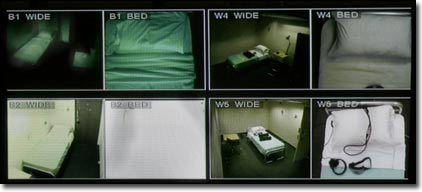How long do people stay alone in the dark?
A BBC Horizon documentary film today will record the experiment of people locked in the dark alone, and their adaptation to this " sensational blockade ".
Adam Bloom is a famous comedian, an extremely extroverted and also admits that he is humorous thanks to the stimulus. He was one of six volunteers who agreed to be locked up in a compartment of a nuclear, lonely and dark bunker. With Bloom, it will be extremely difficult.
Within the first half hour of the experiment, all the volunteers lay down and went to sleep. But the real challenge only started when they woke up and discovered that they could not know what time it was. For 48 hours, these people were watched and filmed by a psychologist. As many hours passed, in the state of not seeing and hearing anything, the volunteers gradually lost direction.
After 24 hours, Bloom felt miserable. Participants, although told in advance, describe what they feel, and that others will hear their voices, but no one will speak up."It's really hard to stimulate your brain without light. It makes me empty. I can feel my brain doesn't want to do anything," he said.
Confining a lonely person in the dark - or sensory blockade - is a controversial trick, used at Guantanamo Bay in an interrogation strategy. And thousands of prisoners in the world have been detained in the same conditions.
Some of the first studies on this issue were done after the Korean War of the 1950s. North American scientists said the tolerance time of experimental students varied. Most are depleted after 72 hours, and very few people can tolerate more than 4 or 5 days. The boredom and pressure of the experiment has become overwhelming. After only 30 hours in that quarantine condition, Adam was one of several volunteers walking back and forth in the bunker, as opposed to the usual reaction.
" Commuting is what we observe in animals as well as humans when they are isolated from the outside world ," said Professor Ian Robbins, clinical psychologist at St George Hospital, adviser for the experiment, said.

Laboratories where volunteers are " locked up " are monitored remotely. (Photo of BBC)
See strange objects
Due to long imprisonment in inanimate condition, volunteers began to " see " hallucinations. Bloom saw empty, oyster shells. Mickey, a postman, saw mosquitoes and fighter planes around his head and it scared him. Claire, a psychology student, did not bother with tiny cars, snakes and zebras, but panicked when suddenly feeling someone in her room.
"There is nothing in the dark to focus on," Professor Robbins said as he watched the behavior of these people . "When no information is available, the brain continues to operate and process and it will eventually generate its own information."
Finally, Adam Bloom and the others were released, ending the experiment. Along with him, many people when going out expressed the high degree of easy marketing. After 48 hours in the dark, Adam wanted to kiss the man who opened the door for himself."I was free and saw the sun, the sky, for the first time in 48 hours. My feeling rushed at the same time and was full of light, sound and taste."
He said he was happy that he had done the experiment and was proud of not giving up early. But he will not do it again.
- Why stay up late or get dark?
- People who stay up late love a night?
- Tips to help office workers sit longer and stay healthy
- Explain the phenomenon of dark black in the daytime in Ha Long
- New explanation of the origin of dark matter
- Video: How do animals see in the dark?
- Each animal has the secret to seeing in the dark differently
- Where people live with the scene of dark sky in the middle of the day
- 11 mysteries about dark matter have not been answered yet
- The mystery of dark energy
- 7 foods that help people survive the end of the world
- Great tips to stay up all night and stay healthy
 'Fine laughs' - Scary and painful torture in ancient times
'Fine laughs' - Scary and painful torture in ancient times The sequence of numbers 142857 of the Egyptian pyramids is known as the strangest number in the world - Why?
The sequence of numbers 142857 of the Egyptian pyramids is known as the strangest number in the world - Why? History of the iron
History of the iron What is alum?
What is alum?